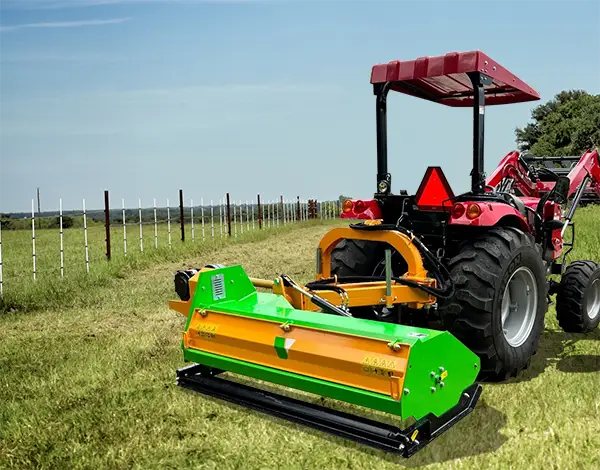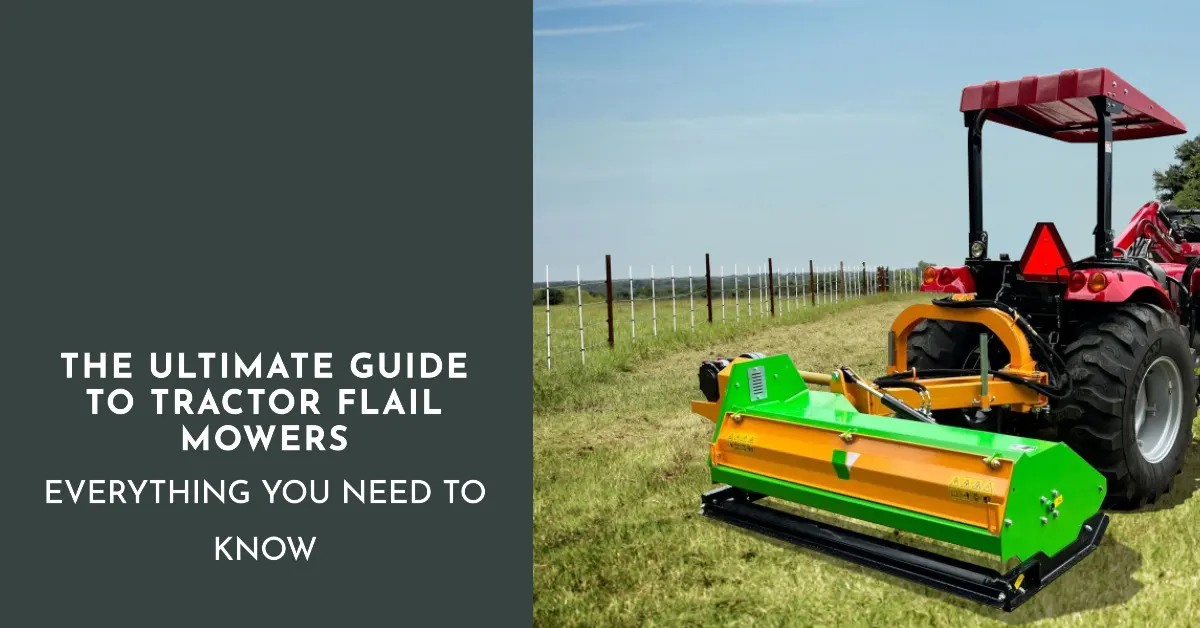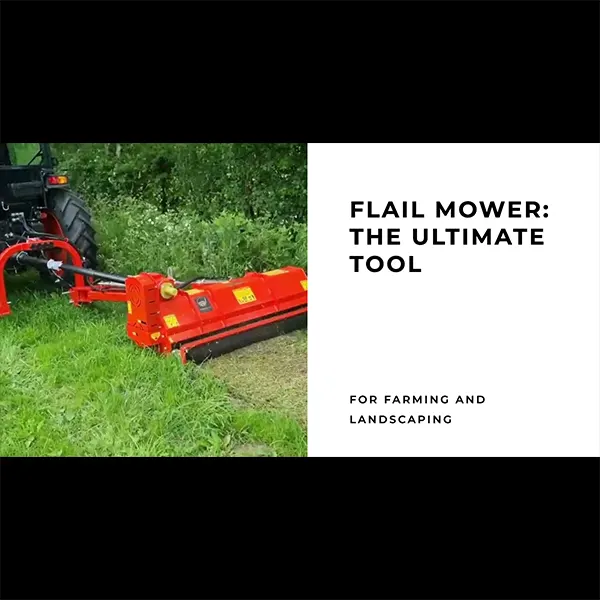Have you ever wondered how to properly maintain your flail mower? Well, you’re in luck! In this article, we’re going to dive into the ultimate guide to flail mower maintenance. Whether you’re a seasoned pro or just starting out, this guide will provide you with all the tips and tricks you need to keep your flail mower running smoothly and efficiently.
First, let’s talk about what exactly a flail mower is. A flail mower is a type of agricultural machinery that is used to cut grass, weeds, and other vegetation. It consists of a rotating drum with many small pieces of metal, called flails, attached to it. These flails spin rapidly, cutting through the vegetation with ease.
Now that we know what a flail mower is, let’s get into the maintenance. Regular maintenance is crucial to keeping your flail mower in top shape. This includes cleaning it after each use, checking and tightening any loose bolts, and lubricating the moving parts. By following these simple steps, you can ensure that your flail mower will last for years to come.
In the upcoming article, we’ll take a closer look at each step of flail mower maintenance and provide you with detailed instructions on how to perform them. We’ll also address common issues and troubleshooting tips, so you’ll be well-prepared to tackle any problems that may arise. So, if you’re ready to learn more about flail mower maintenance, keep reading and get ready to become a pro at keeping your machine in top shape.

Understanding Flail Mowers
A flail mower is a powerful tool that is commonly used in agricultural and landscaping applications. It consists of a rotating drum with multiple blades or flails, which are designed to cut and mulch vegetation. Unlike traditional rotary mowers, flail mowers are known for their ability to handle tough, dense weeds, brush, and even small trees.
What is a Flail Mower?
A flail mower is a type of mower that uses flail blades to cut and mulch vegetation. These blades are attached to a rotating drum, which is powered by an engine or hydraulic system. Flail mowers are commonly used in agricultural fields, orchards, vineyards, and roadside maintenance.
How does a Flail Mower work?
Flail mowers work by utilizing the spinning drum and flail blades to cut vegetation. As the drum rotates, the flail blades swing around, hitting and cutting the vegetation in their path. The blades are specifically designed to deliver a precise cutting action, making it easier to cut through tough weeds and brush.
The design of a flail mower allows it to provide a more uniform and consistent cut compared to other types of mowers. The blades cut the vegetation into smaller pieces, which are then evenly distributed over the mowed area. This promotes better mulching and helps to prevent the growth of weeds.
Benefits of Using a Flail Mower
Flail mowers offer several advantages over other types of mowers. Here are some of the key benefits:
-
Versatility: Flail mowers can handle a wide range of vegetation, including tall grass, weeds, brush, and small trees. This versatility makes them suitable for various applications, such as maintaining fields, clearing overgrown areas, and shredding crop residue.
-
Durability: Flail mowers are built to withstand heavy-duty use. The robust construction and high-quality materials ensure that the mower can withstand the demands of tough vegetation and challenging terrain.
-
Mulching Capability: The cutting action of the flail blades helps to create fine mulch from the mowed vegetation. This mulch can be left on the ground, where it acts as a natural fertilizer, improving soil health and promoting the growth of new vegetation.
-
Safety: Flail mowers are designed with safety in mind. The enclosed drum and blades reduce the risk of debris thrown from the mower, protecting both the operator and surrounding property.
Routine Maintenance
Routine maintenance is crucial for keeping your flail mower in optimal working condition. Regular inspections and cleaning can prevent potential issues and ensure that the mower performs at its best. Here are some important routine maintenance tasks:
Inspecting the Flail Mower
Regular inspection of your flail mower is essential to identify any potential issues or wear and tear. Inspect the blades, the drum, and other components for any signs of damage. Check for loose or missing hardware and replace any damaged parts promptly.
Cleaning the Flail Mower
After each use, it is important to clean the flail mower to remove any debris or plant material. Use a brush or compressed air to clean the blades, drum, and housing. Pay special attention to the areas around the flails, as they can accumulate debris and affect the mower’s performance.
Checking and Changing the Oil
Regularly check the oil levels in your flail mower and change the oil as recommended by the manufacturer. Clean oil is vital for proper lubrication and smooth operation of the mower. Be sure to use the recommended oil type and follow the manufacturer’s instructions.
Sharpening the Flail Blades
Sharpening the flail blades is essential for maintaining a clean and efficient cut. Dull blades can result in uneven cutting and increased power consumption. Use a sharpening tool or a grinding wheel to sharpen the blades. Follow the manufacturer’s guidelines for the correct sharpening angle and technique.
Preventative Maintenance
In addition to routine maintenance, preventative maintenance helps to address potential issues before they become major problems. Here are some important preventative maintenance tasks to consider:
Checking the Flail Belt
The flail belt is an important component that drives the rotation of the flail blades. Regularly inspect the belt for signs of wear, such as cracks or fraying. Replace the belt if necessary to prevent unexpected breakdowns.
Inspecting the Bearings
The bearings in your flail mower play a crucial role in its smooth operation. Regularly inspect the bearings for any signs of wear, noise, or looseness. Replace any damaged or worn bearings to ensure the longevity of your mower.
Maintaining the Hydraulic System
If your flail mower is powered by a hydraulic system, it is essential to maintain the system properly. Regularly check the hydraulic fluid levels and inspect for any leaks. Replace the fluid as recommended by the manufacturer and address any leaks promptly.
Greasing the Flail Mower
Proper greasing ensures that all moving parts of your flail mower operate smoothly. Regularly grease the necessary parts, such as the bearings, shafts, and pivot points. Use the recommended grease type and follow the manufacturer’s guidelines for the correct intervals.
Troubleshooting Common Issues
Even with regular maintenance, issues may arise with your flail mower. Knowing how to troubleshoot common problems can help you keep your mower running smoothly. Here are some common issues and their potential solutions:
Flail Mower Not Starting
If your flail mower fails to start, check the battery and connections first. Ensure that the battery is fully charged and the terminals are clean and secure. If the battery is not the issue, check the ignition switch and the fuel system for any blockages or malfunctions.
Loss of Power
If you notice a loss of power while using your flail mower, it may be due to a clogged air filter or a fuel system problem. Check and clean the air filter, and inspect the fuel lines and filters for any blockages. If the issue persists, consult a professional for further diagnosis.
Excessive Vibration
Excessive vibration can indicate an issue with the blades, bearings, or drive system of the flail mower. Inspect the blades for any damage or imbalance. Check the bearings for wear and replace if necessary. If the issue continues, it is recommended to have a professional inspect the mower.
Uneven Cutting
Uneven cutting can be caused by various factors, such as dull blades, uneven ground, or incorrect cutting height. Sharpen or replace the blades if necessary. Adjust the cutting height to ensure a consistent cut. If the issue persists, check the condition of the levelers and adjust as needed.

Replacing Worn Parts
Over time, certain parts of your flail mower may wear out and need replacement. It is important to identify and order the correct parts to ensure a proper fit and optimal performance. Here are some common parts that may need replacement and steps for their replacement:
Identifying and Ordering the Correct Parts
When ordering replacement parts for your flail mower, it is crucial to identify the correct part numbers. Refer to the mower’s manual or consult the manufacturer’s website for the correct part numbers. Order the parts from a reputable supplier to ensure their quality and compatibility.
Step-by-Step Guide for Replacing Flail Blades
To replace flail blades, first, ensure that the mower is powered off and the blades are not rotating. Remove the old blades by loosening the retaining bolts or pins. Replace them with the new blades, making sure they are securely attached. Refer to the mower’s manual for specific instructions and torque values.
Replacing the Flail Belt
To replace the flail belt, start by removing any debris or obstacles around the belt area. Loosen the tensioner and remove the old belt. Install the new belt by following the routing diagram provided by the manufacturer. Adjust the tensioner to the recommended specifications and test the mower’s operation.
Fixing Damaged Bearings
Damaged bearings should be replaced as soon as possible to prevent further damage to the flail mower. To replace a bearing, first, remove the necessary components, such as the belts and shafts. Remove the damaged bearing and install the new one, making sure it fits securely. Reassemble the mower and test its operation.
Safety Tips for Maintenance
When performing maintenance on your flail mower, it is important to prioritize safety. Here are some essential safety tips to follow:
Properly Powering Down the Flail Mower
Before starting any maintenance tasks, ensure that the flail mower is powered off and the engine or hydraulic system is properly shut down. Disconnect the power source or engage any safety features to prevent accidental starts.
Using Personal Protective Equipment (PPE)
Wear the appropriate personal protective equipment (PPE), such as safety glasses, gloves, and ear protection, when working on your flail mower. PPE helps to protect you from debris, noise, and potential injuries.
Safe Handling and Storage of Flail Blades
When handling flail blades, exercise caution and wear protective gloves. Use proper storage techniques to prevent injuries and damage. Store the blades in a designated area, away from children and pets.
Cautionary Measures for Hydraulic System Maintenance
If your flail mower is equipped with a hydraulic system, take extra caution when performing maintenance tasks. Follow the manufacturer’s guidelines for safe hydraulic system maintenance and avoid contact with hot or pressurized components.

Specialized Maintenance Techniques
In addition to basic maintenance tasks, there are some specialized techniques to keep your flail mower in top shape. These techniques address specific components and ensure their proper functioning. Here are some specialized maintenance techniques:
Maintenance for Flail Mower Attachments
If your flail mower has attachments, such as a roller or a collector, it is important to maintain them properly. Clean the attachments regularly to remove any debris or buildup. Inspect them for wear and damage, and replace any worn parts as needed.
Cleaning and Greasing the Roller Bearings
If your flail mower has roller bearings, they require special attention. Regularly clean and grease the roller bearings to ensure smooth operation. Use a suitable grease recommended by the manufacturer and follow their guidelines for the correct intervals.
Lubrication for Gearbox and Chain Drive
The gearbox and chain drive in your flail mower require proper lubrication for optimal performance and longevity. Use the recommended lubricant and apply it according to the manufacturer’s instructions. Regularly check the oil levels and replenish if necessary.
Inspecting and Repairing Hydraulic Hoses
If your flail mower is equipped with hydraulic hoses, regularly inspect them for any signs of damage or leaks. Replace any damaged hoses promptly to prevent hydraulic system failures. Follow the manufacturer’s guidelines for the correct hose maintenance and repair procedures.
Seasonal Maintenance
Flail mowers require different maintenance tasks depending on the season. Seasonal maintenance helps to prepare the mower for specific weather conditions and ensures optimal performance. Here are some important seasonal maintenance tasks:
Preparing the Flail Mower for Winter Storage
Before storing your flail mower for the winter, thoroughly clean it to remove any debris. Inspect the mower for any potential winterization issues, such as loose or damaged components. Apply a rust inhibitor or protective coating to vulnerable parts. Store the mower in a dry and secure location.
Spring Cleaning and Maintenance
In the spring, inspect your flail mower for any winter damage and address it promptly. Clean the mower thoroughly, including the blades, drum, and housing. Check all components for any signs of wear and perform necessary maintenance tasks, such as lubrication and blade sharpening.
Adjusting Cutting Height for Summer
In the summer, adjust the cutting height of your flail mower to suit the desired grass length. Follow the manufacturer’s guidelines for the recommended cutting height and adjust the mower accordingly. This ensures a consistent and aesthetically pleasing mowing result.
Fall Maintenance and Winterizing
In the fall, prepare your flail mower for the colder weather ahead. Clean the mower and inspect for any signs of wear or damage. Address any issues promptly and lubricate all necessary components. Consider applying a protective coating to vulnerable parts to prevent rust during the winter months.

Professional Servicing and Inspections
While regular maintenance is essential, there are instances when professional servicing and inspections are necessary. Professional technicians have the expertise and specialized tools to identify and address complex issues. Here are some important considerations regarding professional servicing and inspections:
When to Seek Professional Servicing
If you encounter persistent issues with your flail mower or are unsure how to address a particular problem, it is best to seek professional servicing. A professional technician can diagnose and repair complex issues, ensuring the safe and efficient operation of your mower.
Choosing a Qualified and Experienced Technician
When selecting a technician for maintenance or repairs, choose someone who is qualified and experienced in working with flail mowers. Check their certifications, references, and customer reviews to ensure their expertise and reliability.
Inspection Checklist for Flail Mower Maintenance
To ensure a thorough inspection, create a checklist of all the necessary maintenance tasks for your flail mower. Include routine and specialized maintenance tasks, as well as any specific components or areas to inspect. Use the checklist as a guide during maintenance or when seeking professional inspections.
Benefits of Regular and Professional Maintenance
Regular and professional maintenance offers several benefits for your flail mower. It helps to prevent major breakdowns, prolongs the mower’s lifespan, and ensures the safety of the operator. Regular maintenance also helps to maintain optimal performance and efficiency, resulting in a well-maintained and visually appealing landscape.
Conclusion
Proper and regular maintenance is key to keeping your flail mower in optimal working condition. By following this ultimate guide to flail mower maintenance, you can ensure the longevity, performance, and safety of your mower. Remember to perform routine and preventative maintenance tasks, address common issues, replace worn parts as needed, and prioritize safety during maintenance. By doing so, you can enjoy the many benefits of using a flail mower while keeping your landscapes well-maintained and visually appealing.


I am Randy, the author behind ImplementExperts.com. Drawing from decades of experience, I aim to provide valuable insights, expert advice, and practical recommendations to help you make informed decisions in agriculture.